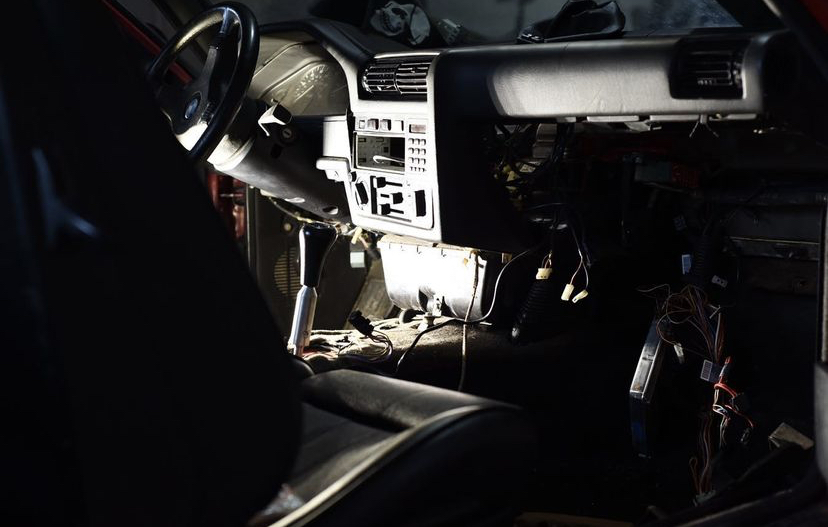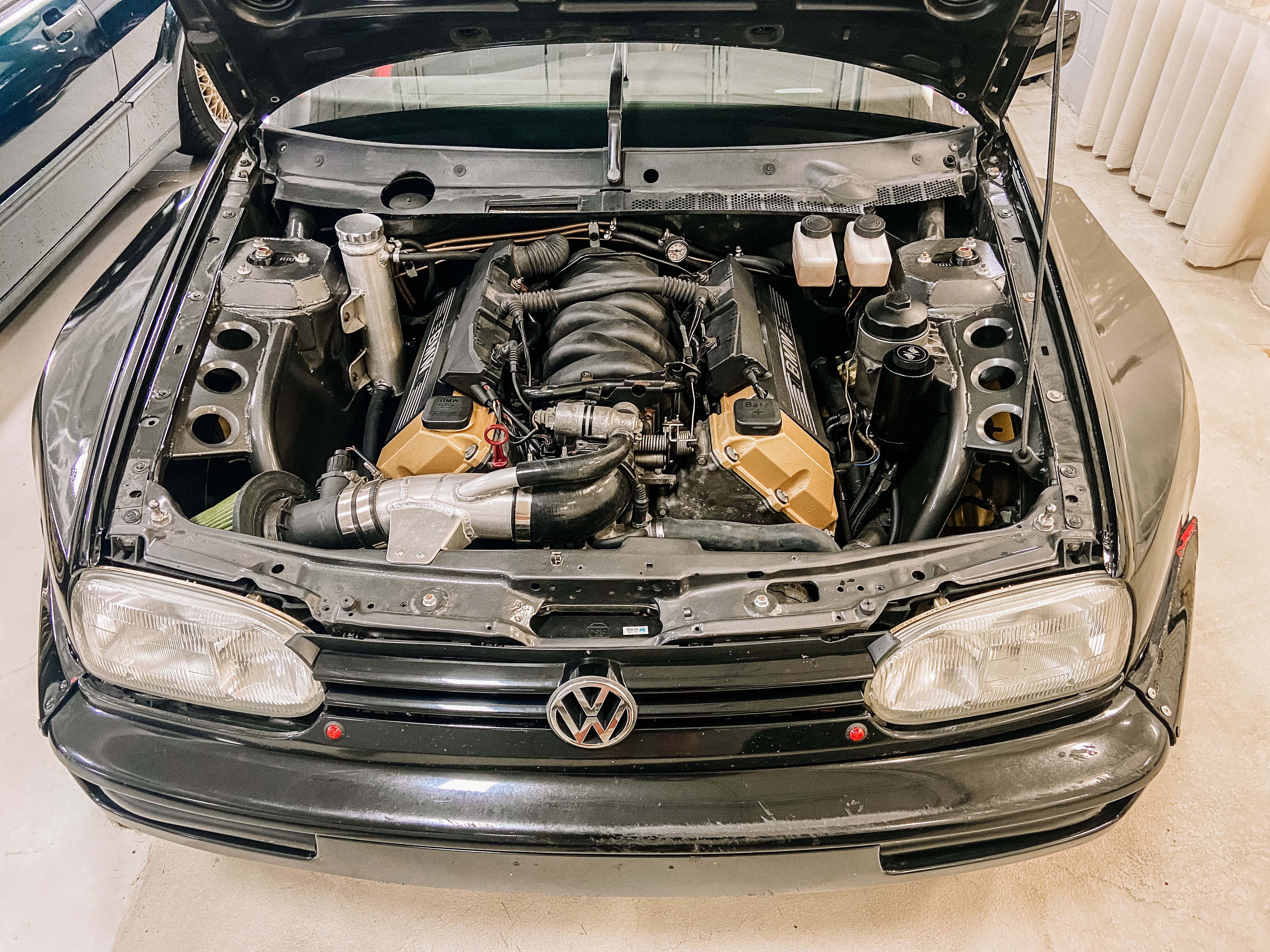Engine swaps are fairly common, even among the non-enthusiast crowd. Whether you’re simply swapping in an identical engine to replace a completely broken one or trying to stuff the biggest thing you can into your little VW for all the power, the fundamental principles are roughly the same. In this article, we’re going to cover many of the common roadblocks when it comes to engine swaps. Grab your engine hoist, lots of drain pans, and let’s dig into learning what you need to know before you start thinking about pulling your engine.

Not all engine swaps are the same. Beyond the specific model differences, there are a few universal categories for engine swaps and they require different amounts of work to complete. Perhaps the easiest swap (in most cases) is the direct engine replacement. If you have an N54 and you destroy your block, the easiest and cheapest way to get back on the road is with a replacement engine. Some of your accessories may need to be transferred to your new engine, but you’re just replacing what was already there. Naturally, that means it bolts right up, all the wiring plugs in, and you’re ready to go. It’s still a lot of work, but it doesn’t take any real effort to make it work.
Then, there’s the next step up, which is replacing your engine with a different power plant from the same manufacturer or one that shares a similar layout to what was in there. This is easiest with an engine from the same manufacturer as your car. Take, for instance, the common 24v swap seen in E30s. It isn’t too much extra effort to throw in something like a 2JZ because it’s an almost identical layout. What about the wiring, you say? Well, if the engine you’ve chosen wasn’t what came in your car, then you’ll have to wire everything you want to work to either a factory ECU that matches your engine or to a standalone unit you program yourself. Either way, whether you choose to S52-swap your E30 or 2JZ swap it, you’re still going to have to do about the same amount of fabrication, wiring, and tinkering to get it running and driving. We’re not saying a 2JZ is as easy to swap as an S52 into an E30, especially not with the amount of info online about the M5X/S5X conversion, but we are saying that you won’t be doing a whole lot different in terms of hurdles to jump.
Finally, there’s the most difficult swap you can undertake. This is an engine that is neither the same layout nor the same manufacturer as the car you’ve chosen. Take our resident mad scientist, Mike, for example. He took most of a MK3 GTI and stuffed a BMW M60 V8 in it, RWD converted it and had to fabricate nearly everything to make it fit and stay in place himself. Not to mention the full roll cage, rear-radiator setup with hard coolant lines running inside the rocker panels, and effectively everything inside, under, and around the car. Anything is possible, it all depends on how much experience, creativity, patience, time, and money you have to make it happen.

So, the topic at hand, YOU want to swap your engine. Well, unfortunately, if you’re reading this, then you likely have limited to no experience performing an engine swap. We’re going to go ahead and say you probably aren’t attempting the most difficult swap, a different manufacturer/different layout engine. So let’s focus on the more common swaps like direct replacements and same-manufacturer/layout upgrades.
The first thing you need to consider is why you’re swapping your engine and what makes the most sense for your setup. It’s a bit like car shopping; there may be a million cars to choose from on the open market, but what fits your wants, needs, and budget will narrow it down to realistically only a handful of options. If your main goal is just to get back on the road, take the path of least resistance with an identical engine. After all, it’s just nuts, bolts, and metal. Not a lot to it.
But, if your goal is more power, or you need something better suited to a particular goal, you should look at what options you have within your manufacturer’s range. Many of the engines available today are used widely across the range of vehicles produced by that company or were available in many models, so it may be that your car is somewhat ready to receive a different engine if that engine was an available option in your car. Look at something like the MK3. If you have a four-pot engine in yours, you know a 12v VR6 will be a relatively painless swap, as it was an available option for the GTI and Jetta, which share engine bays (for the most part) across the range of trim levels.
Now, assuming know why you’re swapping your engine and have chosen what you want to drop in your car, there are a few more things you need to consider. Unfortunately, there are too many differences between all the options out there to give you exactly what you need and have it apply to everyone, but we can still give you a basic checklist of things you’ll probably have to buy, make, or find in a scrapyard.
Wiring / ECU / Immobilizer

Your engine needs power to run and a brain to control all of it. If you’re just dropping in a replacement engine, this just means you have to plug up what you already have and you’re set. But if you’re doing something like an S52 swap in your E30, then you’ll need to think about three specific things. First, you need to make sure your ECU is correct for your engine. Pulling the whole harness and factory ECU from your donor car along with the engine is one way, but another option is to use a standalone system. The standalone option is particularly useful for working around immobilizers, which many modern cars feature. If you decide to stick with the ECU that is paired to your engine, you’ll either need to trick the system by wiring in the key and ignition cylinder along with the immobilizer (if separate from the ECU) so that your engine runs or tune it out with a software flash.
There are honestly reasons to pick either a standalone or a factory ECU option, it just depends on what you want. If you know the engine setup you’ve chosen is going to stay the same in the long term, and you’re on a budget, then the factory ECU is hands down a better choice unless you just want to create additional work for yourself. Some swaps are easier done with a standalone anyway, so you may be better off just biting the bullet and going that route from the beginning. However, if you are someone who likes things to be exactly the way you want them, future-proofed for possible upgrades down the road, and tunability on the fly, then you really should consider a standalone system over a factory ECU.
Drivetrain Mounts

With the brains of the car sorted on the front end, the next thing to do is physically see how your engine will drop into your car. Until your engine and transmission are mocked in place, you won’t be able to plan any wiring, so figuring that out is the next step and the first real bit of actual progress towards permanently fitting your engine. Since what you’re putting in your car isn’t what came out of it, there is almost no chance your stock engine arms, drivetrain mounts, and possibly transmission cross member (where applicable) will fit. You may even need a different front subframe, which is the case with S54 swaps in E30s. Some more common swaps, like M50/S50 swaps in E30s, have aftermarket solutions for the drivetrain components, others will require custom solutions. The best way to mount your engine has likely been documented online, so forums will be your friend. Regardless, it’s always a good idea to physically drop the engine and trans into place so you can see how everything will line up. This will give you a chance to measure for engine arms, check clearances, and see what all might need to be cut, massaged, or deleted to finish your swap.
Transmission:

While you’re working through your drivetrain mounts, you’ll need to have your transmission. Often, the transmission that came in your car won’t be a good fit for your new engine, especially if you’re making way more power. There are three options here. The first is to use the transmission that came with your donor engine, like a ZF 5-speed with the S52. The second is to adapt a different transmission, like a CD009 from a 350z, by using a bell housing adapter designed to mate that transmission to your engine of choice. This is by far the most work but the least expensive way to get a highly capable transmission into your car if you plan on making a bunch of power. Finally, there are often off-the-shelf transmissions you can buy brand-new that are designed to work in places they weren’t originally intended to. This is more popular with the domestic crowd but sometimes applied to the Euro scene. If you’re throwing an LS into your E36, running a ZF might not be the best option. The T56 and CD009 have become fairly standard in that world and can be bought ready to drop in if you have the budget to spend on one.
Exhaust:

It would be surprising to find an engine that didn’t come in your car that allowed you to use the factory exhaust. Even in cars that offered that engine as an option can be difficult to adapt a full factory exhaust as you’ll still have to worry about different routing, hangers, and possibly relocating things under the hood that may interfere with the headers or be at risk of damage from the high heat. This is especially true with turbo manifolds and turbos, which generate metric shit-tons of heat. You can always go fully custom, but it will come down to your skills as a fabricator and access to the equipment you need to make your own exhaust. That, or farm it out to a local exhaust shop, which means spending more money.

We suggest that you try to make as many off-the-shelf parts work that you can. This will allow you to purchase something you know will work on the front end and reduce the amount of custom work needed to finish your exhaust. Common swaps, like VR6 and 24v BMW engines, often will have swap-specific exhaust manifolds that allow you to easily adapt your engine to the rest of your exhaust, so definitely make sure what you’re trying to swap has something like that available before you bust out the welder and tube bender.
Cooling System:

It may come as no surprise to you that the existing cooling system in your car will probably not work with your new engine setup. If you’re lucky, you can adapt the radiator and hoses from the donor car, but in some cases, this won’t work. You may have to get creative depending on what engine swap you’ve chosen. This will also mean either adapting to an electric fan or replacing the original fan and shroud with something slimmer. Regardless, you’ll need to figure out how much space you have where you want to mount your radiator, determine hose lengths/routing, and sort out the fan wiring. Just remember, your radiator needs cool air flowing across it, so unless you’re like Mike Day, a rear-mounted setup probably isn’t the way to go.
Maintenance:

Finally, with everything mocked up, you can’t just drop your new setup straight into its new home. Well, you can, but it might not be a good idea. Unless you want to pull the engine again, many times you’ll find that it’s nearly impossible to service your newly swapped car. That’s why the last things you should do before final assembly after you’ve jumped all those hurdles is tackling any maintenance the engine might need. With it out of the car, you’re in a prime position to tear it apart and replace anything that could ever go bad. Main seals, piston rings, all the engine gaskets, freeze plugs, even rotating assembly bearings should all be inspected and replaced as necessary. This doesn’t mean you have to replace everything, but it is the right time to inspect it all and replace components proactively. If you know pulling that oil pan off or yanking the transmission is going to be hell with the engine in the car, it’s better to start fresh than make it a problem for near-future you. Once you’ve tackled all the internal stuff, you can fill it up with fresh fluids, toss in those new filters, and you’re ready for that glorious first start!
Wrapping Up:
As we mentioned, no two engine swaps are ever going to be identical. When it comes to stabbing a different power plant in your car, even in the best situations, you’re still facing a mountain of work and much of your approach will have to come from your creative brain with the whole thing laid out in front of you. Regardless, all swaps will have a similar road map to completion, which is why we hope this article has helped point you in the right direction. These common challenges are most of what you’ll face in one form or another, all that’s left is for you to start wrenching. If you’re swapping something, let us know! We love to hear about what our community is doing in their garage. If you have something to share, let us know in the comments. Who knows, maybe you’ll find yourself in a future edition of Tuned In Weekly.
Special thanks to Miles, Christian, April, Will, and Ben – we’ve swapped so many things together over the years, I had to use shots from our adventures for this article. One day we’ll all be back in the same garage tinkering on E30s again like we never left.
The crew in the photos:
@quirkdup
@rogue5e30
@biffgnarly
@deathmachinegarage
@das_vader
@denizendesigns









Well i bought a never finished project, i was tossed a amazing 1,800$ for this 325i 2004 m54 e46 2.5 with a 3.0 euro spec donor engine. No transmission change. The mechanic didnt have a clue about how to go about putting the engine in but he straight wired it together, making his own changes to the car when it comes to the wiring. Cruise control aint hooked up, and transmission codes for torque reduction and torque interface have me puzzled. They wont stay cleared, the speedometer is off by a few mph. What should i do to fix this car? I love driving this masterpiece but this lag in highway speeds wont even let me pull up a slight incline going the speed limit which is quite embarrassing since i live in the mountains.
Hey Alec – sounds like you might be having some issues with the ECU/TCM – the DME (ECU) handles all of it. I would assume the transmission in your 325 is not the same as what was in the 3.0 and I’m also assuming its an automatic. As far as the speedo being off, if you have a different wheel/tire size with a different rotating diameter than the factory diameter, that will account for your speedo discrepancy. Remember, the encoder that registers for wheel speed is not going to change its values for the spaces between the ‘clicks’ it measures to determine speed. If your rotating diameter changes, then it will not know and continue sending an identical signal as before, it just wont be 100% correct. Id suggest you have your DME programmed specifically to work with what you have, or, rip it all out and go standalone to eliminate any confusion in the DME for your setup. Hope that helps!